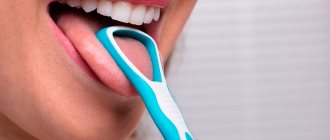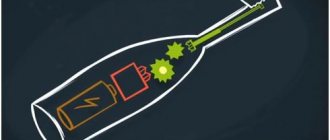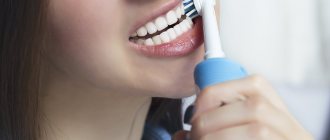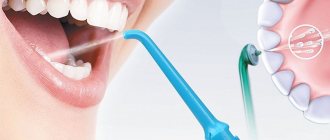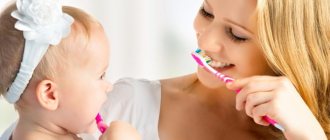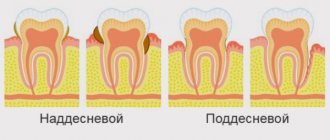Daily oral hygiene is a routine process, brought to the point of “automation”. Often we brush our teeth without thinking about the rules, the position of the brush and the direction of movement. Meanwhile, not only the aesthetic appeal of a smile, but also its health depends on how well oral hygiene is performed. Many dental problems can be avoided (prevented or eliminated) only by following the basic rules of effective teeth brushing.
Why do we brush our teeth?
Millions of microorganisms multiply in the mouth, the vital activity of which is usually completely invisible.
The immune system prevents bacteria from entering the body and causing harm to health. Meanwhile, leftover food stuck between the teeth begins to rot if not removed. Plaque appears, which releases acid and destroys the enamel. Poor cleaning leads to the development of diseases such as caries, periodontitis, gum inflammation, stone formation, halitosis (bad breath), stomatitis, gastritis, and ulcers. An increase in the number of pathogens in the mouth leads to weakened immunity and frequent infectious diseases.
Teeth cleaning methods
There are different methods of cleaning teeth. The standard method for brushing teeth is:
- Apply a small amount of paste to a clean brush;
- clean the upper jaw from the outside from the gums to the edge, starting from the farthest ones;
- clean your teeth from the inside with sweeping movements;
- clean the lower jaw in the same way;
- clean your tongue from root to tip (we recommend reading: how and how to properly clean your tongue from plaque at home?);
- clean the interdental space with floss;
- rinse your mouth with mouthwash.
The standard method is the best for brushing your teeth.
You can clean your teeth in any condition using the standard method. Other methods of teeth cleaning used in dentistry:
- The Leonardo method allows you to clean the oral cavity without damaging the gums. Moving the brush from the gum to the edge, clean the enamel from plaque. Hold the brush perpendicularly. With the jaws closed, clean the outer surfaces, and with the jaws open, clean the inner surfaces.
- Using the Bass method, the cervical area of the teeth is thoroughly cleaned. The brush should be positioned at an angle of 45 degrees to the surface. Clean with vibrating movements.
- The Fones method differs in that cleansing occurs with circular movements of the brush. It is not recommended to use this technique if you have gum disease.
Improper brushing of teeth
Let's admit it, we brush our teeth automatically. And we often do it wrong: we clean them with movements left and right, sherk-sherk. With this method of cleaning, soft plaque is transferred from the surface of the teeth to the interdental spaces and becomes clogged there. As a result, there is a danger of gum damage and the appearance of a wedge-shaped defect, especially on protruding teeth. A wedge-shaped defect is a lesion of a tooth in the area of contact with the gum. It looks like a step that resembles a wedge. The dimensions can range from barely noticeable to complete chipping in the future.
Standard method of brushing teeth Pakhomova G.N.
This method is recommended by most Russian dentists. It was invented by G.N. Pakhomov - professor of dentistry.
- Cleaning begins from the upper jaw in the following order - from the right molars to the front ones, then finishes on the left molars.
- On the lower jaw, the left major ones are cleaned first, then the anterior ones, and lastly the right molars.
- The front and back surfaces are cleaned with sweeping movements from bottom to top, with the brush head at an angle of 45° to the gum.
- It is important to make 10 movements for each tooth.
- Contaminants from the chewing side are removed by moving the head back and forth.
- To clean the front teeth, the brush is placed vertically and moved in a sweeping motion.
The Pakhomov method helps to effectively clean the oral cavity, but for the interdental spaces additional means are needed - irrigators, threads and a tongue scraper.
Treatment appropriate to the specific situation
To date, ALS cannot be cured, but there are methods to prolong the patient’s life and improve its quality. But we must understand that each method must be relevant to the stage of the disease, its course, the condition and desires of the patient and his family.
The course of the disease varies from person to person, and so does the stage of the disease. Now the disease ALS is conventionally divided into 4 stages, they are characterized by the degree of involvement of muscle groups in the disease - arms, legs, muscles responsible for speech and swallowing.
It is important to clearly understand what result the patient will receive from a particular type of care: does he need the drug for his condition? will it improve his quality of life? or will the quality of life remain the same, but the course of the disease will slow down? Is this method suitable for him personally? and what kind of help might he need in the future? For each specific type of assistance, you need to contact a professional who specializes in it and can answer your questions: this could be a specialist in nutrition, ventilation, etc.
Listed below are methods for improving prognosis and quality of life, which have a certain evidence base and are included in recommendations for helping patients with ALS - in other countries and in Russia (in our country, such guidelines are currently undergoing the approval procedure, but today recommendations for ALS can be found in National Guide to Neurology).
How to choose a toothbrush
Your dentist's advice will be of great help in choosing a toothbrush.
A soft brush may not clean your teeth as effectively, and hard bristles can damage your enamel and gums. Most often, a medium-hard brush is used. Many people are interested in what is better - an electric brush or an ordinary one. Dentists recommend brushing your teeth with an electric brush no more than 2-3 times a week, because... otherwise the enamel may be damaged. Good reviews about ultrasonic brushes. They allow you to remove plaque in hard-to-reach places due to ultrasonic vibrations that lift plaque from the surface. Recommended for sensitive teeth, braces, periodontal diseases, and other situations where mechanical cleaning is difficult. However, the peculiarities of such brushes are their rather high cost, as well as the presence of contraindications - for cancer patients, people with cardiovascular diseases, mental illnesses, pacemakers and children under 9 years old.
Manual removal of dental plaque
The first tools for removing dental plaque were proposed back in the 7th century. Currently, instruments designed for manual removal of mineralized dental plaque are usually collectively referred to as “scalers.” But despite the age of this invention, manual removal of dental plaque is still in demand.
Advantages:
- Firstly, manual removal of dental plaque has no contraindications.
- Secondly, the cost of such a procedure is affordable for every patient.
- Thirdly, in some areas, tartar can be removed only with the help of these tools.
- Well, the most important advantage is the quality of work. It has been proven that hand instruments after processing form the smoothest root surface, which allows teeth to remain protected from plaque and tartar for longer.
The disadvantages of this method include:
- Labor intensity and time consumption when performing the procedure. In addition, the main criterion for the thoroughness of dental plaque removal is the doctor’s tactile sensation, which does not always help, especially in hard-to-reach places.
- The method is traumatic. Many patients complain of pain not only during the procedure, but also for several days after it. Based on my practice, this method is more suitable for patients of a periodontist, who, after removing dental plaque, prescribes a series of manipulations or procedures.
Choosing a toothpaste
The paste should also be used taking into account the oral condition of each person.
One has sensitive teeth - a special toothpaste is needed to reduce sensitivity. Another has such microflora in his mouth that plaque builds up very quickly - he needs an antibacterial one. In the third case, there may be bleeding gums - a paste is needed for gum health. Very often all this can be combined, then a combined action paste is needed. When choosing a paste manufacturer, you must also focus on your feelings. After all, it is very important that brushing your teeth is comfortable, and if the taste of the toothpaste causes nausea, a person is unlikely to benefit from it. It happens that, apparently due to the individual characteristics of the oral microflora, after brushing your teeth with certain pastes, after some time a film forms on the oral mucosa, which creates discomfort. In this case, it is better to replace the paste.
Many people want to make their teeth lighter and for this they constantly use whitening toothpastes. Here you need to know that modern whitening pastes most often contain enzymes that facilitate easier removal of plaque. Although these pastes do not harm the enamel, they can only be used daily for 1-2 months. Highly abrasive whitening toothpastes (used mainly for smokers) are more effective, but also dangerous to the enamel. They can only be used 1-2 times a week.
Cleaning teeth with a sandblaster (Air-Flow method)
Thanks to this method, you can gently and without consequences remove soft deposits (but not a lot of tartar!), and also lighten the enamel by 0.5 tones (relevant for smokers and coffee lovers). The meaning of the device is very simple - an abrasive (usually based on soda) is poured into a special flask. Water enters there (into the flask), and this entire mixture, under high pressure, cleans off all the deposits.
Advantages:
- The technology allows you to clean the most inaccessible corners of the oral cavity (for me personally, cleaning the interdental spaces with this method brings great joy. A sandblasting machine cleans in a way that no other machine can do).
- The ability to soften any deposits and particles of tartar, as well as remove plaque and age spots.
- Speed of implementation - in standard cases it will take up to 30 minutes.
- Comfort and painlessness. There are times when this method causes discomfort. But you and I can easily cope with it, thanks to additional recommendations.
- Safety - the device does not damage enamel and gums, and the natural components of polishing powders do not cause harm.
- Additional polishing of tooth enamel - abrasive particles eliminate roughness and smooth the surface of the teeth.
- Gum massage is an additional effect of the procedure, which improves blood supply and metabolic processes in soft tissues.
- Ability to clean braces, implants and other orthopedic structures.
Flaws:
- The main disadvantage of sandblasting is that it does not remove massive mineralized formations (tartar). The device only removes pigmented plaque and soft bacterial deposits well, and does a much worse job even with small tartar.
How much toothpaste do you need?
Many people mindlessly squeeze toothpaste along their toothbrush because advertising taught them to do so: back in the 40s, a guy on an advertising poster carefully squeezed toothpaste along the brush.
The fact is that the task of marketers is to teach us to buy more than necessary and thus sell us as many products as possible. The main task of toothpaste is to provide mechanical cleaning of the surface of the teeth with a brush. The paste is designed to soften the hardness of the brush, reduce its trauma and soften plaque. Too much toothpaste will reduce the effectiveness of your toothbrush.
So how much toothpaste should you squeeze onto your brush for effective brushing? Every dentist will tell you that there should be a “pea-sized amount” of toothpaste on your brush.
To stop being a victim of advertising and give up the habit of squeezing the paste along the brush, simply squeeze the paste across the brush rather than along it.
Chemical method
The chemical method of removing stones is an auxiliary method that is used in combination with other methods. Its essence is that if the stones are very hard, they are first softened using special acidic chemicals. Applied to the surface of the stone, they effectively and quickly dissolve part of the stone within a minute. After which the stone can be easily removed using an ultrasonic tip.
Benefits of chemical stone removal:
- Risk reduction - the chemical method softens the stones and makes them easier to remove. This reduces the risk of injury with the ultrasound method.
- Whitening effect - after exposure to acids on tooth enamel, the tooth becomes 2-3 shades lighter
- Time saving – the process takes from 30 to 60 seconds.
Flaws:
- This method has one significant drawback. When in contact with tooth enamel, the acids used in this technique have a negative effect on the protective mechanisms of the teeth, as a result of which the tooth can easily deteriorate.
Is it possible to brush your teeth with soda?
In addition to regular toothpastes, so-called folk remedies are used to clean teeth.
The most popular of these is baking soda. Due to its high abrasive properties, it is believed that this product can help whiten teeth at home. You will undoubtedly achieve a whitening effect, but only due to the fact that the soda will literally tear off the top layer of enamel. Similar results can be obtained by brushing your teeth with charcoal, although it has disinfecting properties. There are those who believe that you can brush your teeth with salt, as it has a lot of useful elements. It is possible that salt helps remove plaque, and in some cases, tartar, but negative factors should also be taken into account. Firstly, it must be very finely ground, and secondly, you need to remember that your enamel will not last forever and it is also undesirable to expose it to daily salt. In general, modern dentistry is of the opinion that teeth cleaning should be as gentle as possible. Most dentists categorically do not recommend using the above-described remedies.
How to properly brush teeth with braces?
For those who wear braces, regular and high-quality teeth cleaning is an essential necessity.
Since iron brackets and arches make it difficult to access the tooth surface, “brace wearers” have their own rules for caring for braces and the oral cavity. You will have to clean up after every meal, using various devices in the form of special brushes, brushes, dental floss and an irrigator. Key points about brushing teeth with braces:
- Use a special orthodontic brush with V-shaped bristles.
- Position the brush at a 45° angle to the gum and, using gentle pressure, use short back-and-forth strokes to brush each tooth individually for approximately 10 seconds.
- Go over the inside and outside surfaces of your teeth, making sure the brush reaches the outermost back teeth.
- Use brushes to clean your braces and hard-to-reach surfaces between them and your teeth.
- Use floss to clean the spaces between teeth.
- Finish your brushing with mouthwash.
- For hard-to-reach areas, use a dental irrigator.
Important to remember!
- The tooth has five surfaces, and the brush processes only three of them. Therefore, in addition to a toothbrush, it is necessary to use interdental floss and interdental brushes daily to clean the lateral surfaces of the teeth.
- Don't forget to brush your tongue. To do this, you can use the back of a brush or a special scraper.
- Remember! Regular and thorough dental care is an important part of caring for the health of the whole body.
Take care of your teeth and smile!
Features of brushing teeth with restoration structures
Compliance with the rules of oral hygiene is of great importance in cases where there are various types of restorations in the mouth - such as veneers, lumineers and crowns, as well as bridges and implants.
Plaque accumulates on artificial surfaces no less than on natural teeth, and sometimes even more. In addition, the patient’s future health depends on the quality of oral hygiene. For example, if in the case of implantation you neglect to brush your teeth, then you can get inflammation and rejection of the implant. As for bridges, the space between the bridge and the gum will require careful care. In the case of ceramic veneers and lumineers, hygiene is also equally important. At the border between them and the native enamel, food debris can accumulate and plaque can form, which can ultimately lead to caries. The danger lies in the fact that under the thinnest plates, which are veneers and lumineers, you may not notice how the carious process develops. Irrigators will also be useful for artificial restorations - special devices that, using water pressure, help clean even the most inaccessible places. In addition, the device heals the gums and generally improves the effectiveness of oral hygiene. Today, manufacturers offer a fairly wide range of models, so you can choose an irrigator to suit any needs and budget.
No matter how thoroughly and regularly we brush our teeth, it is still not enough. Once every six months or a year, it is necessary to visit a hygienist’s office, where, with the help of ultrasound and sandblasting machines such as Air Flow, the teeth undergo general treatment, and their owner gains a confident and beautiful smile!
Removing dental plaque using ultrasound (ultrasonic teeth cleaning)
The ultrasonic method involves removing dental plaque using special scaler tips. The essence of the technique is that the tip, oscillating at high frequencies (from 25 to 50 kHz), loosens and removes tartar. The whole process is accompanied by an abundant supply of water from the tip. Water plays a very important role in removing stones: it protects teeth from overheating, washes away stone fragments, and removes “weak” stones mechanically.
Advantages:
- Fast – With a range of convenient tips available, stone removal is usually very fast. On average, the procedure takes 30-40 minutes.
- Price – in most dental clinics, the price for dental calculus removal is calculated depending on the number of teeth. Often, not all teeth have tartar, which means there is no need to overpay for a segment (half jaw/8 teeth at once), which may not have tartar on them.
- Simultaneous irrigation of the surface with a medicinal product. Modern ultrasonic devices have reservoirs for antiseptic solutions instead of water, which increases the cleansing of the periodontal pocket. The cavitation effect, which occurs when the nozzle vibrates in a solution of water or antiseptic, destroys the membrane of bacterial cells, providing a powerful antimicrobial effect.
- Comfort – as a rule, removal of dental plaque by ultrasound is a painless procedure and does not cause much discomfort to the patient (of course, when used correctly).
But there is also a downside to using ultrasonic teeth cleaning:
- The ultrasonic tip is dangerous in the wrong hands. The fact is that if the techniques are not followed, you can damage not only the gums, but also tooth enamel. In addition, if the doctor uses an old generation handpiece, or does not supply enough water, the tooth may overheat, which can cause inflammation of the dental pulp - pulpitis. However, if used correctly, these problems are not terrible.
- Quite a large number of contraindications. We discuss the presence of certain diseases with each patient.
Toothpicks and chewing gum
Dentists do not recommend using toothpicks at all. The wood from which they are made flakes when cleaned. The separated particles can remain between the teeth and, over time, begin to rot and cause inflammation. And also, while using a toothpick, you can injure your gums without even noticing it. Alternatively, use thread. It is a mistaken belief that chewing gum will help get rid of plaque and stuck pieces of food. Yes, undoubtedly, some parts of the remaining food will stick to the gum.
But during the chewing process, when the gums press against each other, these same particles can get stuck in the interdental space. In addition, recently placed fillings that have not withstood prolonged exposure “like” to stick to chewing gum.
Chewing gum does not strengthen the gums; this happens in the process of uniform chewing, and not when squeezing the jaws in one place. Chewing gum is usually one-sided and can lead to muscle atrophy on the opposite side because it will not receive the stress it needs.
Another disadvantage is that constant chewing will lead to overload of the periodontium. Against this background, periodontitis and gingivitis can develop.
Chewing gum contains dyes and sweeteners. Do not forget that dye E131 (contained, for example, in Stimorol chewing gum) causes the formation of cancer cells, E171 – liver and kidney diseases.
To remove food debris after eating, it is better to rinse your mouth with water 2-3 times or use a mouthwash or foam.
What to choose – toothpaste or tooth powder?
The correct answer is toothpaste .
Despite the fact that the powder can even clean teeth more effectively in some cases, its use has been proven to be unsafe for enamel. The same can be said about whitening toothpastes that contain abrasive particles. They can be used from time to time (according to dentists - no more than once a week), but for constant use it is better to choose a softer option. In general, the choice of toothpaste depends on your taste preferences, as well as the final result you get after brushing. In general, a toothbrush and toothpaste should be sufficient, however, dentists also recommend additional use of dental floss. The fact is that there are surfaces of teeth that are quite difficult to clean with a regular brush. However, much depends on the structure of the oral cavity - for some, the distance between the teeth is quite large, so floss is not needed, but for others, on the contrary, it is too small, and the floss can damage the gums. Subsequently, such an injury can lead to periodontitis - therefore, the use of dental floss should still be based on the individual characteristics of the person. Sources:
- https://MikDent.ru/estetika/uhod/kak-pravilno-chistit.html
- https://doctorslon.ru/company/articles/kak-pravilno-chistit-zuby-tekhnika-chistki-manualnoy-i-elektricheskoy-shchyetkoy/
- https://azbyka.ru/zdorovie/kak-pravilno-chistit-zuby
- https://www.StartSmile.ru/gigiena-polosti-rta/kak-pravilno-chistit-zuby.html
- https://DrZubastik.ru/chistka-zubov/pravila-i-tekhnika.html
- https://dentalgu.ru/statyi/other/chistka-zubov/
